CP-VLSSP United Front and inauguration of the SLFP
By W. T. A. Leslie FERNANDO
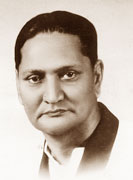
D. A. Rajapaksa |
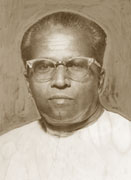
A. P. Jayasuriya |
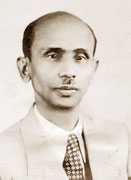
D. S. Gunasekera |
Philip Gunawardena, who left the LSSP with his supporters at the
party conference held on May 14, 1950 forcibly took over LSSP party
headquarters on the following day with the assistance of harbour
workers. They evicted all the others but did not do any harm to Robert
Gunawardena who was there with his hand bandaged because of an injury.
This incident became the subject matter for the daily cartoon in
‘Lankadipa’ titled ‘Apoorva Sahodarayo’ in Sinhala meaning ‘strange
brothers’.
Phillip Gunawardena claimed that his group was maintaining the
continuity of the LSSP formed in 1935. He branded the united party
formed with the merger of the LSSP and the BSP as the ‘Nava Lanka
Samasamaja Party’ (new LSSP). The national newspapers followed suit and
it came to be known as the NLSSP.
The party headed by Philip issued its journal as the ‘Viplavakari
Samasamajaya’ as such it came to be known as the
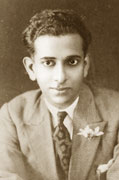
Jayaweera Kuruppu |

George R. de Silva |

Badi-ud-din Mahamud |
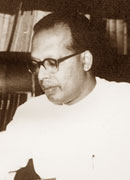
T. B. Ilangaratne |
Viplavakari Lanka
Samasamaja Party (VLSSP) as distinct from the NLSSP. The VLSSP comprised
mainly of the working class whereas all the powerful party cadres were
found in the NLSSP. Soon the VLSSP was faced with financial constraints.
The VLSSP could not maintain forcibly taken party headquarters for
long and its journal too came to an abrupt end. The VLSSPcould not keep
pace with its rival counterpart, the NLSSP. In the meantime the attitude
of Philip Gunawardena towards Trotskyism too underwent a change.
In 1938 Leon Trotsky expected that within 10 years millions all over
the world would adopt Trotskyism and Trotskyites would seize power in
Soviet Russia. These never materialised. On the other hand Stalin by
whatsoever the manner was able to develop Soviet Union to become a world
power. Besides China became a Communist country in 1949 and Communism
was spreading fast in Asia, American continent and even in Europe. The
whole world began to be divided into two camps and Soviet Russia headed
the socialist bloc.
Trotskyism was found only in a few countries like Sri Lanka and
Bolivia and among a handful in countries like France and USA. The LSSP
in Sri Lanka was the strongest Trotskyite mass movement in the whole
world! Philip found that there was no meaning to stick to Trotskyism any
more. Although he acknowledged that there were some good aspects in
Trotskysim, he found that in the prevalent situation it was a
spent-force.
In 1950; the economy in Sri Lanka improved as prices of our rubber
and other export items fetched higher in the world market. The Korean
boom was a blessing to the country. Instead of using the balance of
payments to develop the country, the UNP government reduced the
subsidised price of rice to 25 cents a measure and put down the prices
of other consumer goods. At that time the subsidised price of rice was
36 cents a measure and there was no agitation to reduce it. It was a
step taken by the UNP to win the next election. In the long run it
retarded the progress of the country as moneys could have been used for
the development of the country.Nevertheless the UNP government became
popular as the prices of consumer items went down. At this time Philip
realised that there should be a united front of the Leftists if the UNP
were to be ousted. The LSSP was not amenable to such a unity as it
wanted to form a workers’ and peasants’ government under its own
leadership. Accordingly Philip Gunawardena turned towards the Communist
Party. By this time Philip had given up Trotskyism and there was no
hindrance for him to come to terms with the CP.
In April 1951 a united front between the CP and the VLSSP was formed.
Its aim was to work for the establishment of a government that would
constitute an alliance of all anti-imperialist and anti-UNP forces under
the leadership of the working class. Such a government was to have a
close understanding with the Soviet Union and the Communist China.
The LSSP denounced the CP-VLSSP United Front as a vague formation
without a proper objective to overthrow capitalism. They branded it as a
capitulation of Philip Gunawardena to Stalinism. The LSSP had enough
reasons to take offensive against the move that brought together two of
its rivals and thereby become a formidable challenge to its own
supremacy in the Left.In 1951, there was another significant event in
the political arena in Sri Lanka. The Sinhala Maha Sabha of S. W. R. D.
Bandaranaike with a national agenda was a powerful force in the UNP.
There was a general feeling that S. W. R. D. Bandaranike would succeed
D. S. Senanayake as the Prime Minister. However there was a strong group
in the UNP that abhored nationalism and wanted to prevent S. W. R. D.
Bandaranaike attaining power.
S. W. R. D. Bandaranaike could foresee it. He summoned a conference
of the Sinhala Maha Sabha at Madampe and got a series of resolutions
approved to direct the government towards national aspirations. The UNP
headed by D. S. Senanayake refused to accommodate them. Thereupon in
July 1951 S. W. R. D. Bandaranaike resigned from the post of Minister of
Health and Local Government and joined the opposition in Parliament.
When S. W. R. D. Bandaranaike crossed over to the opposition, D. A.
Rajapaksa, the father of President Mahinda Rajapaksa and the MP for
Beliatta at the time, too followed him. Later A. P. Jayasuriya, D. S.
Gunasekera, George R. de Silva and Jayaweera Kuruppu too joined S. W. R.
D. Bandaranaike. On September 2, 1951, S. W. R. D. together with the MPs
so crossed over inaugurated the SLFP. Independent Socialists like H. Sri
Nissanka MP and other progressives outside Parliament like T. B.
Ilangaratne and Badi-ud-din Mahamud too joined ranks with S. W. R. D.
Bandaranaike to form the SLFP.
Philip could always visualise a progressive inclination in S. W. R.
D. Bandaranaike. That is why after the 1947 elections Philip made an
attempt to form a government of progressives under him. As Bandaranaike
has now crossed over to the opposition, Philip wanted to forge a unity
among the progressives to defeat the UNP. At the annual conference of
the LSSP held in December 1951 Philip distributed a pamphlet among its
members to that effect.In 1950 with the merger of the LSSP and the BSP
the party became stronger. The LSSP strengthened its youth leagues and
prepared for the next general election. It aimed high and at the annual
conference drew up a 14 point programme to form a workers’ and peasants’
government under its leadership. Withdrawal from the British
Commonwealth, abrogation of defence and other agreements, grant of
citizenship to all those who desired to be permanent residents,
nationalisation of all banks and estates over 250 acres were highlights
in its programme.
Although the LSSP was willing to come to some sort of agreement with
the SLFP to defeat the UNP, it was not willing to come to any terms with
the CP-VLSSP United Front. Philip Gunawardena, the Father of Trotskyism
in Sri Lanka joining hands with the CP was a challenge to the LSSP and
it did not like CP-VLSSP United Front gaining ground. All the efforts of
Philip Gunawardena to unite the progressives to defeat the UNP failed.
At the 1952 elections, although steps were taken to avoid the clashes
among the parties in the opposition, that did not come through. The SLFP
clashed with the LSSP in 27 electorates. But the clashe between the LSSP
and the CP-VLSSP United Front was reduced to 06.
The 1952 general election was held at a time favourable to the UNP.
The UNP enjoyed prestige among people for winning the Independence as
promised. As a result of the economic boom, prices of consumer goods had
come down and the cost of living was low. Besides the Colombo Plan and
the Gal-oya Development Scheme had made the UNP popular. The death of D.
S. Senanayake called the ‘Father of the Nation’ swayed some voters to
the UNP led by his son Dudley Senanayake.At the end UNP won 54 seats and
got a comfortable majority in the House of Representatives. The 1952
election was a setback to the Leftists. The LSSP contested 41 seats but
could win only 9. The CP-VLSSP United Front could get only 4 and the
SLFP won 9 seats.
The SLFP faced the 1952 elections without even one year after its
formation. It had no time to get well organised for a general election.
The SLFP winning 9 seats in its first attempt was an indication that it
had the potentiality to be the alternative to the UNP. Its leader S. W.
R. D. Bandaranaike became the Leader of the Opposition in the new
Parliament.
|

